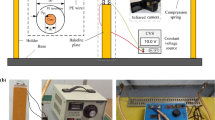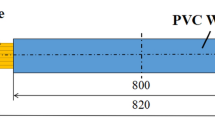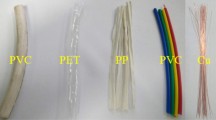Abstract
The fire characteristics of polyethylene (PE) copper wire was investigated using cone calorimetry. The analysis focused on the effect of overload failure and external heat flux on its fire behavior. The mechanism of thermal oxidation of PE insulation by metal cores under overload failure was theoretically analyzed. The time-to-ignition (TTI), heat release rate (HRR), gas emission and mass loss of PE wires were measured. The results show that the TTI and the peak heat release rate (pHRR) are lowest for the 80 A overload current value compared to the 0–70 A overload current value. This is related to the complete thermal degradation behavior of the PE insulation subjected to the Joule heating of the metal core. The thermal thick and thin models of overloaded wires under different current values were verified theoretically and experimentally. As the overloaded wires burn, a peak in HRR occurs, and as the external heat flux increases, the time to reach pHRR decreases, but the peak intensity increases. The fire performance index (FPI) and fire growth index (FGI) of the overloaded wires were also calculated, and the FPI and FGI were minimized when the overload current value was 80 A. Finally, the gas emissions, residues and mass losses of the overloaded wires were analyzed. This work contributes to the understanding of the differences in fire characteristics of overloaded PE copper wires.













Similar content being viewed by others
References
Luo YX, Li Q, Jiang LR, Zhou YH. Analysis of Chinese fire statistics during the period 1997–2017. Fire Saf J. 2021;125(3): 103400.
National Fire Protection Association (NFPA 921), Guide for Fire and Explosion Investigations, 2021 ed., National Fire Protection Association, Quincy, Massachusetts, 2020.
Krongauz VV, Lee YP, Bourassa A. Kinetics of thermal degradation of poly(vinyl chloride). J Therm Anal Calorim. 2011;106(1):139–49.
Zhao YL, Zhang XL, Luo SF, Zhang XL. Effect of oxygen concentration and external radiation on the thermal decomposition and combustion characteristics of electric wire. J Therm Anal Calorim. 2022;147(1):7775–84.
Grayson S, Van Hees P, Green AM, Breulet H, Vercellotti U. Assessing the fire performance of electric cables (FIPEC). Fire Mater. 2001;25(2):49–60.
McGrattan KB, Lock AJ, Marsh ND, Nyden MR. Cable heat release, ignition, and spread in tray installations during fire (CHRISTIFIRE): phase 1-horizontal trays. NUREG/CR-7010, U.S.NRC;2012.
McGrattan KB, Bareham SD. Cable heat release, ignition, and spread in tray installations during fire (CHRISTIFIRE) phase 2: vertical shafts and corridors. Report NUREG/CR-7010, Volume 2, U.S.NRC;2013.
Meinier R, Sonnier R, Zavaleta P, Suard S, Ferry L. Fire behavior of halogen-free flame retardant electrical cables with the cone calorimeter. J Hazard Mater. 2018;342:306–16.
Zhang H, Yao JX, Zhu H, Wang XL. Study on combustion characteristics of cable based on cone calorimeter. Energies. 2022;15(5):1904.
Hirschler MM. Comparison of large-and small-scale heat release tests with electrical cables. Fire Mater. 1994;18(2):61–76.
Barnes MA, Briggs PJ, Hirschler MM, Matheson AF, O’Neill TJ. A comparative study of the fire performance of halogenated and non-halogenated materials for cable applications. Part II tests on cable. Fire Mater. 1996;20(1):17–37.
Babrauskas V. Heat release rates. SFPE handbook of fire protection engineering. Berlin: Springer; 2016. p. 799–904.
Magalie, C, Anne-Sophie, Rodolphe S, Laurent F, Emmanuelle G, Christian L. Fire behaviour of electrical cables in cone calorimeter: Influence of cables structure and layout. Fire Saf J. 2018;99:12–21.
Emanuelsson V, Simonson M, Gevert T. The effect of accelerated ageing of building wires. Fire Mater. 2007;31(5):311–26. https://doi.org/10.1002/fam.944.
Wang Z, Wang J. An experimental study on the fire characteristics of new and aged building wires using a cone calorimeter. J Therm Anal Calorim. 2019;135(6):3115–22. https://doi.org/10.1007/s10973-018-7626-8.
Kerekes Z, Restás Á, Lublóy É. The effects causing the burning of plastic coatings of fire-resistant cables and its consequences. J Therm Anal Calorim. 2019;139:775–87.
Oluwoye I, Altarawneh M, Gore J, Dlugogorski BZ. Oxidation of crystalline polyethylene. Combust Flame. 2015;162(10):3681–90.
Li JY, Li H, Wang QM, Zhang X, Ouyang BH, Zhao JK. Accelerated inhomogeneous degradation of XLPE insulation caused by copper-rich impurities at elevated temperature. IEEE Trans Dielectr Electr Insul. 2016;23(3):1789–97.
GB/T 19666-2019, General rules for flame retardant and fire resistant wire and cable or optical fiber cable [S].
IX-IEC, IEC 60331-2 Standard. https://www.cssn.net.cn/cssn/productDetail/10084e6b261824b27e5650d5429eb8d7. (Accessed 19 April 2009).
Sumitra P. Categorization of cable flammability: intermediate scale fire tests of cable tray installations. Interim report NP-1881, Research Project 1165–1, Factory Mutual Research Corporation, Norwood, MA; 1982.
Elliot P, Whiteley R. A cone calorimeter test for the measurement of flammability properties of insulated wire. Polym Degrad Stab. 1999;64(3):577–84.
ISO I. 5660-1: 2015 Reaction-to-fire tests–Heat release, smoke production and mass loss rate-Part 1: Heat release rate (cone calorimeter method) and smoke production rate (dynamic measurement), Geneva. Switzerland: International Organization for Standardization. 2015.
Tang K, Zhang Y, Jiang S, Li CW, Ma CY, Liu GH, Zhang HM, Yuan BH. A Comparative study on fire hazards of cables used in nuclear power plants based on small- and large-scale experiments. J Therm Anal Calorim. 2022;147:14659–71.
Li Z, Lin QW, Li Y, Lyu HF, Wang HB, Sun JL. Effect of the current on the fire characteristics of overloaded polyvinyl chloride copper wires. Polymers. 2022;14(21):4766.
Hopkins D, Quintiere JG. Material fire properties and predictions for thermoplastics. Fire Saf J. 1996;26(3):241–68. https://doi.org/10.1016/S0379-7112(96)00033-1.
Rhodes BT, Quintiere JG. Burning rate and flame heat flux for PMMA in a cone calorimeter. Fire Saf J. 1996;26(3):221–40. https://doi.org/10.1016/S0379-7112(96)00025-2.
Schartel B, Hull TR. Development of fire-retarded materials-Interpretation of cone calorimeter data. Fire Mater. 2007;31(5):327–54. https://doi.org/10.1002/fam.949.
Thornton W. The relation of oxygen to the heat of combustion of organic compounds. Lond Edinb Dublin Philos Mag J Sci. 1917;33(194):196–203.
Kim MH, Seo HJ, Lee SK, Lee MH. Influence of thermal aging on the combustion characteristics of cables in nuclear power plants. Energies. 2021;14(7):2003.
Wei R, He Y, Zhang Z, He JJ, Yuen R, Wang J. Effect of different humectants on the thermal stability and fire hazard of nitrocellulose. J Therm Anal Calorim. 2018;133:1291–307.
Wang Z, Wei R, Ouyang D, Wang J. Investigation on thermal stability and flame spread behavior of new and aged fine electrical wires. J Therm Anal Calorim. 2020;140:157–65.
Maalihan RD, Pajarito BB. Relationship between tensile modulus and oxygen uptake of pro-oxidant loaded low-density polyethylene films during heat aging. Key Eng Mater. 2016;705:72–6. https://doi.org/10.4028/www.scientifific.net/KEM.705.72.
Fontaine G, Ngohang FE, Gay L, Bourbigot S. Investigation of the contribution to fire of electrical cable by a revisited mass loss cone. Fire Sci Technol. 2015;2017:687–93.
Wang Z, Wei R, Ning X, Xie T, Wang J. Thermal degradation properties of LDPE insulation for new and aged fine wires. J Therm Anal Calorim. 2019;137(2):461–71. https://doi.org/10.1007/s10973-018-7957-5.
Acknowledgements
This study has been funded by the National Natural Science Foundation of China (No. 5207042336) and the Natural Science Foundation of Hebei Province [No. E2021507002]. The authors gratefully acknowledge all these supports.
Author information
Authors and Affiliations
Contributions
Data collection was performed by JD. Data analysis was performed by CPW, HBW, YL and PRM. The manuscript was written by QWL. All authors discussed the results.
Corresponding author
Ethics declarations
Competing interests
The authors declare that they have no known competing financial interests or personal relationships that could have appeared to influence the work reported in this paper.
Additional information
Publisher's Note
Springer Nature remains neutral with regard to jurisdictional claims in published maps and institutional affiliations.
Rights and permissions
Springer Nature or its licensor (e.g. a society or other partner) holds exclusive rights to this article under a publishing agreement with the author(s) or other rightsholder(s); author self-archiving of the accepted manuscript version of this article is solely governed by the terms of such publishing agreement and applicable law.
About this article
Cite this article
Deng, J., Lin, Q., Li, Y. et al. Effect of overload current values on the fire characteristics of polyethylene (PE) copper wires. J Therm Anal Calorim 148, 11695–11705 (2023). https://doi.org/10.1007/s10973-023-12522-5
Received:
Accepted:
Published:
Issue Date:
DOI: https://doi.org/10.1007/s10973-023-12522-5




